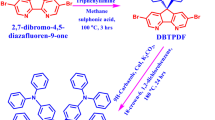Abstract
Two donor-σ-acceptor molecules containing tetrathiafulvalene (TTF) and carbazole moieties were synthesized by the reaction of 9-(4-bromo-butyl)-carbazole (1) with 2,6-bis(hexylthio)-3-(2-cyanoethylthio)-7- (methylthio)-tetrathiafulvalene (2) or 2,6-bis(2-cyanoethylthio)-3, 7-bis(methylthio)tetrathiafulvalene (3) in the presence of CsOH·H2O, respectively. The structures of the molecules were characterized by 1H NMR, 13C NMR, MS, and elemental analyses. They showed negligible intramolecular charge-transfer interaction in their ground states as indicated by their UV-Vis spectroscopics and cyclic voltammetry results. Compared with carbazole, their fluorescence was strongly quenched, which implied that a photo induced electron transfer (PET) interaction between TTF and carbazole moieties occurred.
Similar content being viewed by others
References
Aviram A, Ratner M. Molecular rectifiers. Chem Phys Lett, 1974, 29: 277–286
Khodorkovsky V, Becker J Y. In Organic Conductors: Fundamentals and Applications. New York: Matcel Dekker, 1994, 75–88
Marder S R, Kippelen B, Jen A K Y, Peyghambarian N. Design and synthesis of chromophores and polymers for electro-optic and photorefractive applications. Nature, 1997, 388: 845–851
Imahori H, Sakata Y. Donor-linked fullerenes: photoinduced electron transfer and its potential application. Adv Mater, 1997, 9: 537–546
Bryce M R. Tetrathiafulvalenes as π-electron donors for intramolecular charge-transfer materials. Adv Mater, 1999, 11: 11–23
Tsiperman E, Regev L, Becher J Y, Bernstein J, Ellern A, Khodorkovsky V, Shames A, Shapiro L. Synthesis of a novel rigid tetrathiafulvalene-s-p-benzoquinone diad (TTF-σ-Q) with inherent structural configuration suitable for intramolecular charge-transfer. Chem Commun, 1999 1125–1126
Nielsen M B, Hansen J G, Becher J. Self-complexing tetrathiafulvalene-based donor-acceptor macrocycles. Eur J Org Chem, 1999, 2807–2815
Sadaike S I, Takimiya K, Aso Y, Otsubo T. TTF-porphyrin dyads as novel photoinduced electron transfer systems. Tetrahedron Lett, 2003, 44: 161–165
Martín N, Sánchez L, Herranz M A, Guldi D M. Evidence for two separate one-electron transfer events in excited fulleropyrrolidine dyads containing tetrathiafulvalene (TTF). J Phys Chem A, 2000, 104: 4648–4657
Simonsen K B, Zong K, Rogers R D, Cava M P, Becher J. Stable macrocyclic and tethered donor-acceptor systems: intramolecular bipyridinium and tetrathiafulvalene assemblies. J Org Chem, 1997, 62: 679–686
Li S F, Zhong G Y, Zhu W H, Li F Y, Pan J F, Huang W, Tian H. Dendritic europium complex as single dopant for white-light electroluminescent device. J Mater Chem, 2005, 15: 3221–3228
Tabei E, Fukushima M, Mori S. Conductivity of doped Ncarbazolyl-substituted polysilanes. Synth Met, 1995, 73: 113–116
Chun H, Moon I K, Shin D H, Kim N. Preparation of highly efficient polymeric photorefractive composite containing an isophoronebased NLO chromophore. Chem Mater, 2001, 13: 2813–2817
Lee J H, Park J W, Choia S K. Synthesis and electroluminescent property of a new conjugated polymer based on carbazole derivative: poly(3,6-N-2-ethylhexyl carbazolyl cyanoterephthalidene). Synth Met, 1997, 88: 31–35
Simonsen K B, Svenstrup N, Lau J, Simonsen O, Mϕrk P, Kristensen G J, Becher J. Sequential functionalisation of bisprotected tetrathiafulvalene-dithiolates. Synthesis, 1996, 3: 407–418
Miguel P, Bryce M R, Goldenberg L M, Beeby A, Khodorkovsky V, Shapiro L, Niemz A, Cuello A O, Rotello V. Synthesis and intramolecular charge-transfer properties of new tetrathiafulvalenetetracyanoanthraquinodimethane diad (TTF-σ-TCNAQ) and triad (TTF-σ-TCNAQ-σ-TTF) molecules. J Mater Chem, 1998, 8: 71–76
Bang K S, Nielsen M B, Zubarev R, Becher J. Tetrathiafulvalenephenanthroline macrocycles as redox responsive sensors for metal ions. Chem Commun, 2000, 215–216
Zhang G X, Zhang D Q, Guo X F, Zhu D B. A new redoxfluorescence switch based on a triad with tetrathiafulvalene and anthracene units. Org Lett, 2004, 6: 1209–1212
Flood A H, Nygaard S, Laursen B W, Jeppesen J O, Stoddart J. Locking down the electronic structure of (monopyrrolo)tetrathiafulvalene in [2] rotaxanes. Org Lett, 2006, 8: 2205–2208
Author information
Authors and Affiliations
Corresponding author
Rights and permissions
About this article
Cite this article
Lai, G., Liu, Y., Li, M. et al. Synthesis, spectroscopic, and electrochemical properties of two dyads consisted of tetrathiafulvalene and carbazole. Front. Chem. Eng. China 3, 192–195 (2009). https://doi.org/10.1007/s11705-009-0015-x
Received:
Accepted:
Published:
Issue Date:
DOI: https://doi.org/10.1007/s11705-009-0015-x




